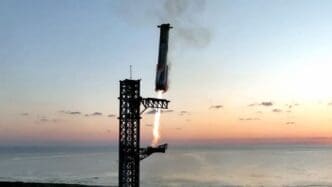In 2024, the realm of space exploration saw remarkable advancements and breathtaking sights, capturing the attention and imagination of astronomers and the public alike. From awe-inspiring celestial events to groundbreaking achievements in space travel, the year was marked by significant milestones that broadened our understanding of the universe.
The year began with a stunning moment as skywatchers across the United States witnessed a total solar eclipse in April. This celestial event, one of the most watched in history, spanned parts of Mexico, the U.S., and Canada, with images capturing the grandeur of the moon obscuring the sun.
In the realm of satellite imagery, NASA astronaut Don Pettit shared captivating visuals in November of Starlink satellites flashing across the International Space Station. These images, with their distinct line streaks, showcased the satellites’ solar panels reflecting sunlight, presenting a unique view of these technological marvels.
Meanwhile, the James Webb Space Telescope (JWST) and the Hubble Space Telescope provided extraordinary insights into our cosmos. Notable was an image capturing two spiral galaxies, IC 2163 and NGC 2207, resembling eyes in a spectacular galactic masquerade. The JWST also revealed intricate details of the Horsehead Nebula, showcasing turbulent waves of gas in new light.
Another marvel was witnessed in October when comet C/2023 A3, known as Tsuchinshan-ATLAS, graced Earth’s skies. Astrophotographers like Miguel Claro captured its brilliant anti-tail, providing breathtaking imagery from various locations, including the Dark Sky Alqueva reserve in Portugal.
In the sphere of space exploration, SpaceX made headlines with its Super Heavy tower catch. The successful maneuver saw the giant rocket caught mid-air by ‘chopstick’ arms, highlighting the progress in reusable rocket technology. This accomplishment was mirrored by SpaceX’s historic third flight of its Starship megarocket, promising even more launches in the coming year.
The commercial spaceflight sector witnessed a pioneering moment with the first-ever commercial spacewalk by the Polaris Dawn crew. This milestone involved testing SpaceX’s new spacesuits, demonstrating the potential for private missions to contribute significantly to space exploration.
Other captivating events included the Perseid meteor shower above Stonehenge, captured in breathtaking detail by photographer Josh Dury, and the eerie view of Hurricane Milton over the Vehicle Assembly Building at NASA’s Kennedy Space Center, captured amidst the turbulent hurricane season.
Astrophotography also highlighted the Pink Running Chicken Nebula, observed by the European Southern Observatory. Its rich textures and star formations provided a glimpse into the early stages of star life, contributing to our understanding of stellar nurseries.
Contributions from the Hubble Space Telescope continued to enrich our knowledge, with images of Eta Carinae, a massive star on the verge of a supernova event. Such observations exemplify the ongoing efforts to monitor and understand stellar evolution.
The year also marked the final mission of United Launch Alliance’s Atlas V rocket, a significant transition as the company shifts focus to its new Vulcan rocket for future national security missions.
Lastly, one cannot overlook the role of the Northern Lights, which illuminated skies in regions previously unvisited by such phenomena, thanks to the heightened solar activity during the solar maximum.
2024 was a landmark year in space exploration and observation, providing insights that will guide future endeavors. This year’s achievements and discoveries remind us of the vastness of our universe and the relentless pursuit of knowledge that drives humanity’s exploration of the cosmos.
Source: Space







